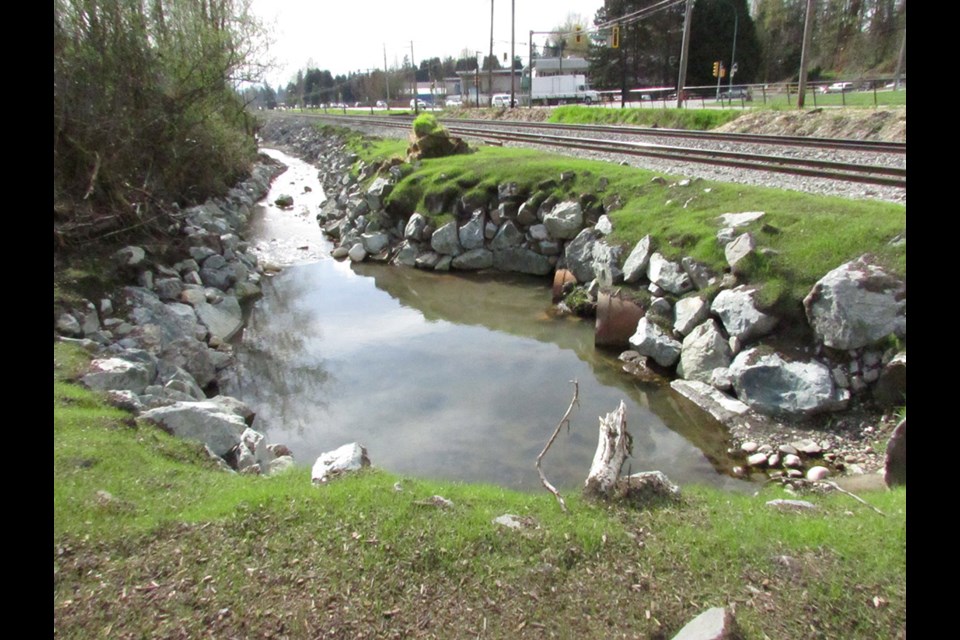CN wrapped up its cleanup on Saturday and recovered most of the 83 cubic metres of coal spilled into Silver Creek and Burnaby Lake, following a train derailment in January.
The coal recovery work finished on April 11, and on Saturday, CN put the finishing touches on restoration work.
The Jan. 11 derailment was caused by heavy rains and a breached beaver dam that washed out the railway tracks close to Brighton Avenue and Government Street. Seven cars derailed, and three tipped over, spilling coal chunks and dust into Silver Creek, which feeds into Burnaby Lake.
CN hired Triton Environmental to assess the spill and create a cleanup plan that accommodated fish and wildlife in the area, and Quantum Murray, a waste-management company, was hired to remove the coal.
According to CN's coal recovery plan, authored by Triton, obtained by the NOW through a freedom-of-information request, there were 82.8 cubic metres of coal spilled into Silver Creek, Burnaby Lake and the Brunette River. Most of the coal (76 cubic metres) was washed downstream into the lake, and about 5.5 cubic metres were left in Silver Creek. There was also a thin layer further downstream in the Brunette, which drains into the Fraser River.
Of the total volume of spilled coal, Triton deemed that 81.4 cubic metres were recoverable. As for the final recovered volumes, CN spokesperson Emily Hamer said the company met the cleanup criteria set out by the Environment Ministry and that "miniscule amounts were left in the water" but couldn't provide any exact figures. However, she did say 140 tonnes (nearly 400 cubic metres) of coal and sediment were recovered and sent to a "local permitted disposal facility."
According to the initial plan, some areas were considered too sensitive to work in without risking fines for damaging salmon eggs or alevins or hibernating turtles. Triton and another consulting company were to salvage amphibians and fish (using nets and electro-fishing) from the work areas and move them 100 metres west of the work zone. There was also a "dive survey" to look and feel for turtles that may be hibernating underwater in the underwater sediment.
Work was done to stabilize Silver Creek, meaning the banks have been built up further from the tracks and reinforced with large rocks, and the beavers that caused the derailment appear to have moved on. The restoration plan also included cleaning the culvert and removing trees deemed hazardous.
The NOW also obtained documents from the Transportation Safety Board, through an access-to-information request, that showed CN's engineering services knew about the beaver dam prior to the accident.
"The beaver dam had been removed by engineering services personnel several times during the past year and had been inspected by engineering services less than 24 hours before the derailment," stated Kirby Jang, the board's director of investigations operations, in a letter to Luc Bourdon, Transport Canada's director general of rail safety.
According to Jang's letter, there was another track patrol scheduled for the evening before the derailment, but that didn't happen because the track patrol vehicle had a mechanical failure.
According to the letter, CN also has a "beaver activity assessment program," which only deals with beaver dams that are out of sight from the railway. Engineering personnel deal with anything within sight of the tracks, and the dam that caused the derailment was close to the tracks and visible from the railway line.
The Transportation Safety Board suggested Transport Canada "may wish to review the effectiveness of the training provided to those responsible for inspecting and assessing the hazards posed by beaver dams."
More than 100 tiny Western painted turtles were removed from the nesting area at Burnaby Lake, close to the coal spill. The endangered turtles had to be moved to facility in North Vancouver, so that CN's consultants could use the beach to access the lake. The turtles will be returned to the lake in the future.
Silver Creek is an area considered sensitive habitat by Fisheries and Oceans Canada. Environment Canada's enforcement branch is still monitoring the situation and reviewing information to determine if there will be any Fisheries Act charges.



